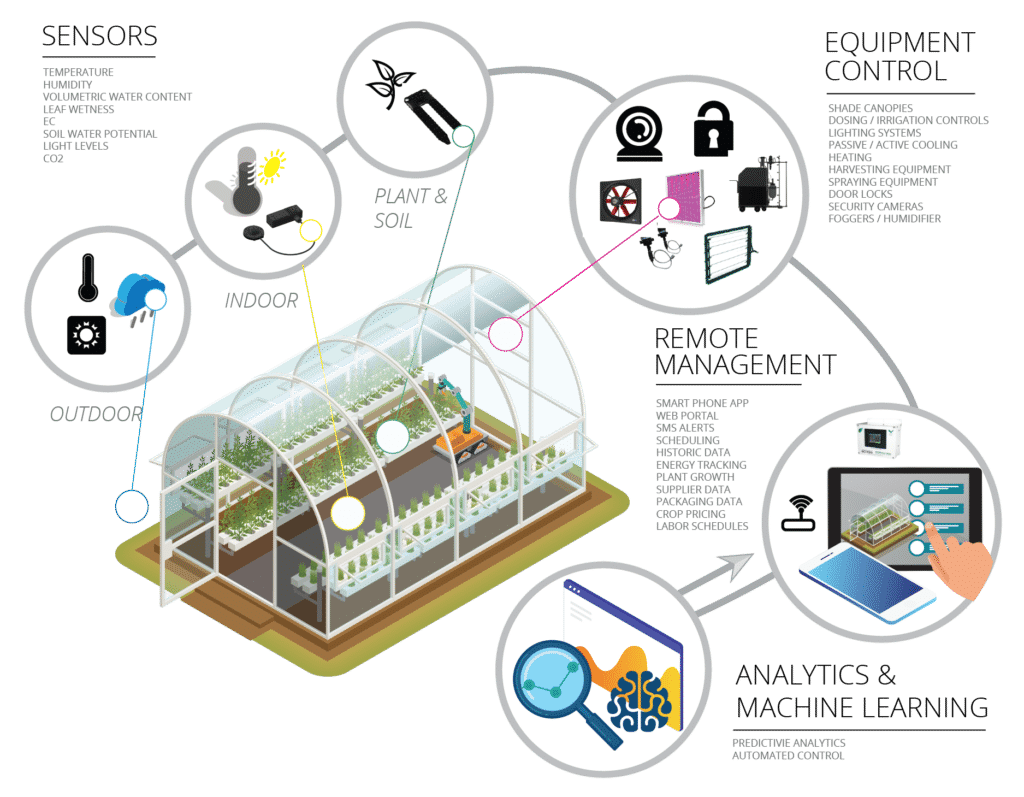Imagine stepping into a world where technology and nature work hand in hand to produce fresh, vibrant crops all year round. This is the promise of smart greenhouses.
As someone who cares about sustainability and innovation, you might find yourself intrigued by how these modern marvels are revolutionizing agriculture. Smart greenhouses are not just about growing plants; they’re about optimizing resources, enhancing productivity, and ensuring that what you eat is as fresh and healthy as possible.
Have you ever wondered how climate control, automated watering systems, and advanced data analytics can transform a simple greenhouse into a futuristic farming hub? This article will unravel the mysteries of smart greenhouses, offering you insights into how they operate, the technology behind them, and why they are crucial for our planet’s future. Dive in to discover how you can be part of this green revolution.

Technology In Smart Greenhouses
Smart greenhouses employ advanced technologies to enhance plant growth and efficiency. These systems automate processes, minimizing human intervention. From climate control to data analytics, technology plays a vital role. It ensures optimal conditions for crops, leading to higher yields and resource savings.
Climate Control Systems
Climate control systems adjust temperature and humidity inside greenhouses. Sensors monitor environmental conditions continuously. The system maintains ideal climate settings automatically. This reduces the risk of plant stress and enhances growth.
Automated Irrigation
Automated irrigation systems deliver water precisely when needed. Sensors detect soil moisture levels. The system waters plants based on real-time data. This ensures efficient water use and healthier plants.
Led Lighting Technology
LED lighting provides plants with necessary light wavelengths. Grow lights mimic sunlight, promoting photosynthesis. They are energy-efficient and customizable. This helps plants thrive even during low-light conditions.
Data Analytics And Monitoring
Data analytics tools track plant growth and environmental conditions. They collect data from various sensors. Analyzing this data helps optimize greenhouse operations. It allows for informed decisions and improved crop outcomes.
Integrated Pest Management
Integrated pest management uses technology to control pests. Sensors detect pest activity early. Automated systems apply treatments selectively. This reduces chemical use and protects crops from damage.

Benefits Of Smart Greenhouses
Smart greenhouses offer controlled environments that enhance plant growth. They reduce water usage and optimize energy efficiency. These greenhouses adjust conditions like temperature and humidity, ensuring ideal plant health.
Smart greenhouses are transforming the way we grow plants by merging technology with agriculture. They offer numerous benefits that make them appealing to gardeners and farmers alike. Imagine controlling the climate within your greenhouse with just a few taps on your smartphone. Isn’t that fascinating? Dive into the benefits of smart greenhouses and discover how they can enhance your gardening experience.Enhanced Climate Control
Smart greenhouses allow you to maintain the perfect environment for your plants. You can adjust temperature, humidity, and light levels effortlessly. This ensures optimal growth and healthier plants. Have you ever struggled with unpredictable weather affecting your crops? With smart greenhouses, you can say goodbye to those worries.Efficient Water Usage
These greenhouses are designed to conserve water. They use advanced irrigation systems that provide precise water delivery. This reduces waste and ensures your plants get exactly what they need. Isn’t it amazing how technology can help save water while keeping your plants thriving?Energy Savings
Smart greenhouses utilize energy-efficient systems to reduce consumption. Automated systems adjust lighting and ventilation to minimize energy use. This not only benefits the environment but also cuts down your electricity bills. Imagine the peace of mind knowing you’re saving energy while nurturing your plants.Increased Crop Yield
You can achieve higher productivity with smart greenhouses. By optimizing conditions, plants grow faster and produce more. This can lead to increased profits and a more sustainable gardening practice. Have you ever wondered how you could get more from your garden? Smart greenhouses provide the answer.Real-time Monitoring
Stay connected to your greenhouse with real-time monitoring. Receive alerts and updates about your plants’ conditions straight to your device. This empowers you to make quick decisions and prevent potential issues. Isn’t it reassuring to always have a pulse on what’s happening in your greenhouse?Reduced Labor Costs
Automation reduces the need for manual labor. You can manage your greenhouse efficiently without constant supervision. This saves time and money, allowing you to focus on other tasks or hobbies. Consider how much time you could reclaim with smart technology managing your plants. Smart greenhouses offer practical solutions to common gardening challenges. They bring convenience, efficiency, and sustainability right to your fingertips. Are you ready to embrace the future of gardening with smart greenhouses?Challenges And Solutions
Smart greenhouses face challenges like energy efficiency and climate control. Solutions include using sensors and automated systems to optimize conditions. Advanced technologies help manage resources, ensuring sustainable and productive growing environments.
Smart greenhouses have emerged as a beacon of hope for sustainable agriculture. Yet, they are not without their hurdles. Navigating these challenges can be daunting, but every problem has a solution. Let’s delve into the common hurdles you might face and explore practical ways to overcome them.Challenge 1: High Initial Costs
Starting a smart greenhouse can be financially demanding. The technology involved is cutting-edge, and the initial setup can be expensive. Solution: Consider starting small. You can scale up as you see the return on your investment. Look into government grants and subsidies aimed at promoting sustainable farming practices. Collaborate with tech companies that might offer flexible payment plans.Challenge 2: Technical Complexity
The technology used in smart greenhouses can be intricate. For those not tech-savvy, this can seem overwhelming. Solution: Invest in user-friendly systems. Many smart greenhouse solutions come with intuitive interfaces. Attend workshops or training sessions to better understand the technology. Collaborate with tech professionals or agronomists who can provide guidance.Challenge 3: Energy Consumption
Smart greenhouses can consume a lot of energy. This can counteract their environmentally-friendly benefits. Solution: Incorporate renewable energy sources like solar panels. This not only reduces carbon footprint but also cuts down on energy costs. Use energy-efficient LED lighting and automate systems to ensure they only run when necessary.Challenge 4: Data Management
With numerous sensors and devices, the amount of data generated can be overwhelming. Managing and analyzing this data is crucial. Solution: Utilize cloud-based systems to store and analyze data. This ensures that information is accessible from anywhere and is secure. Use data analytics tools that provide actionable insights instead of raw data.Challenge 5: Pest And Disease Control
While smart greenhouses offer controlled environments, they are not immune to pests and diseases. Solution: Implement integrated pest management systems. Use sensors to detect early signs of infestations or diseases. Regularly update and monitor these systems to ensure they are effective. Are you considering a smart greenhouse for your agricultural needs? How do these challenges align with your current concerns? By taking proactive steps, you can turn these challenges into opportunities, ensuring your smart greenhouse thrives.
Future Of Smart Agriculture
Smart greenhouses offer a glimpse into the future of farming. These structures use technology to control climate, ensuring optimal plant growth. Farmers can monitor conditions remotely, boosting efficiency and yield.
The future of smart agriculture is not just a vision; it’s rapidly becoming a reality. As our global population grows, so does the demand for more efficient and sustainable farming practices. Smart greenhouses are at the forefront of this transformation, offering innovative solutions to age-old agricultural challenges.The Rise Of Smart Greenhouses
Smart greenhouses are changing how we think about farming. They use advanced technology to monitor and control environmental conditions like temperature and humidity. This means plants can grow faster and healthier, reducing the need for harmful chemicals. Imagine having a greenhouse that adjusts its own settings based on weather forecasts. This is already happening, thanks to smart sensors and IoT (Internet of Things) technology. These advancements allow for precise control, maximizing crop yield and quality.Why Technology Is Key
Technology plays a crucial role in the success of smart agriculture. With the integration of AI and machine learning, smart greenhouses can predict plant diseases before they spread. This proactive approach saves time and resources. Data analytics is another powerful tool. By analyzing patterns and trends, farmers can make informed decisions. This leads to better crop management and efficient resource use, saving money and reducing waste.Sustainability In Smart Agriculture
Sustainability is at the heart of smart agriculture. Smart greenhouses minimize water usage through drip irrigation systems. This not only conserves water but also ensures plants receive the right amount of nutrients. Energy efficiency is another benefit. Many smart greenhouses use renewable energy sources like solar panels. This reduces the carbon footprint, contributing to a cleaner and greener planet.Challenges And Opportunities
While smart greenhouses offer numerous benefits, they also come with challenges. The initial setup cost can be high, which may deter small-scale farmers. However, the long-term savings and increased productivity often outweigh these costs. There is also a learning curve. Farmers need training to effectively use the technology. But this opens up opportunities for educational programs and community support networks.Your Role In The Future Of Agriculture
Have you ever thought about how you can contribute to this agricultural revolution? Supporting local initiatives that promote smart farming is one way. You can also spread awareness about the benefits of smart agriculture in your community. Consider starting your own small-scale smart greenhouse project. With the right resources and guidance, you can make a positive impact. The future of agriculture is in your hands, and every small step counts. Smart agriculture is not just about technology; it’s about creating a sustainable future for all. As we move forward, the role of smart greenhouses will only become more vital. Are you ready to be part of this exciting journey?Conclusion
Smart greenhouses blend technology with nature. They help grow plants efficiently. Sensors monitor conditions like temperature and humidity. Automation ensures optimal plant care. This leads to higher yields and healthier crops. Smart greenhouses save resources and reduce labor. They are a step towards sustainable farming.
The future of agriculture looks promising. Embracing smart technology can make a big difference. It’s time to consider smart greenhouses for better farming results. This approach can benefit both small and large farms. Let’s support innovation for a greener tomorrow.


